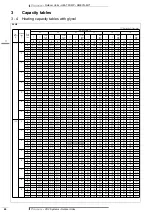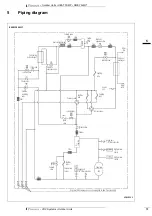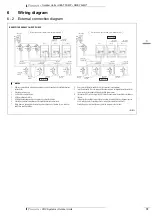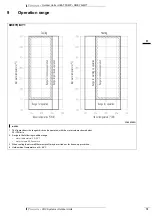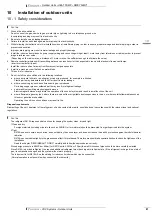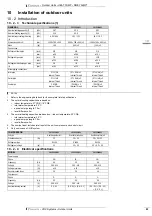
3
1
3
• VRV Systems • Outdoor Units
69
• Outdoor Units • HEAT PUMP • RWEYQ-MY1
3
Capacity tables
3 - 5
Capacity correction factor
RWEYQ10,20MY1
•
Rate of change in cooling capacity
•
Rate of change in heating capacity
3D048283
NOTES
1
These figures illustrate the rate of change in capacity of a standard indoor unit system at maximum load (with the thermostat set to maximum) under
standard conditions.
Moreover, under partial load conditions there is only a minor deviation from the rate of change in capacity shown in the above figures.
2
With this outdoor unit, evaporating pressure constant control when cooling, and condensing pressure constant control when heating is carried out.
3
Method of calculating A/C (cooling / heating) capacity:
The maximum A/C of the system will be either the total A/C capacity of the indoor units obtained from capacity characteristic table or the maximum
A/C capacity of outdoor units as mentioned below, whichever smaller.
Calculating A/C capacity of outdoor units
•
Condition: Indoor unit combination ratio does not exceed 100%
Maximum A./C capacity of outdoor units = A/C capacity of outdoor units obtained from performance characteristics table at the 100% combination
x capacity change rate due to piping length to the farthest indoor unit
Condition: Indoor unit combination ratio exceeds 100%
Maximum A./C capacity of outdoor units = A/C capacity of outdoor units obtained from capacity characteristics table at the combination
x capacity change rate due to piping length to the farthest indoor unit
4
When overall equivalent pipe length is 80m or more, the diameter of the main gas and liquid pipes (outdoor unit-branch sections) must be increased.
[Diameter of above case]
5
Read cooling / heating capacity rate of change in the above figures based on the following equivalent length.
Overall equivalent length = (Equivalent length to main pipe) x Correction (Equivalent length after branching)
Choose a correction factor from the following table.
When cooling capacity is calculated: gas pipe size
When heating capacity is calculated: liquid pipe size.
6
Example RWEYQ10MY1
In the above case
(Cooling) Overall equivalent length = 80m x 1.0 + 40m = 120m
(Heating) Overall equivalent length = 80m x 0.5 + 40m = 80m
The correction factor in cooling capacity when Hp=0m is thus approximately 0.82
The correction factor in heating capacity when Hp=0m is thus approximately 0.9
EXPLANATION
OF
SYMBOLS
H
p
: Level difference (m) between indoor and outdoor units with indoor unit in inferior position
H
M
: Level difference (m) between indoor and outdoor units with indoor unit in superior position
L
: Equivalent pipe length (m)
α
: Capacity correction factor
1.0
1.0
0.90
0.90
0.87
0.87
0.83
0.81
0.81
0.83
0.85
0.85
0.92
0.92
0.95
0.95
0.97
0.97
50
40
40
30
30
40
50
60
70
80
90
100
110
120
130
140
30
20
20
20
10
10
10
0
0
0
(m)
(m)
H
M
L (m)
α
α
H
P
1.0
0.97 0.95
0.92 0.90
0.87
1.0
0.97 0.95
0.92 0.90
0.87
50
40
40
30
30
40
50
60
70
80
90
30
20
20
20
10
10
10
0
0
0
(m)
(m)
H
M
L (m)
α
α
H
P
Model
liquid
RWEYQ10MY1
ø 19.1
RWEYQ20MY1
ø 19.1
Rate of change
(object piping)
Correction factor
Standard size
Size increase
Cooling (gas pipe)
1.0
-
Heating (liquid pipe)
1.0
0.5
Model
liquid
RWEYQ10MY1
ø 9.5
RWEYQ20MY1
ø 15.9
Equivalent lenght
Equivalent lenght
Indoor unit
Outdoor unit
Branch
80 m
40 m
Gas pipe : Size increase
Liquid pipe : Standard size






